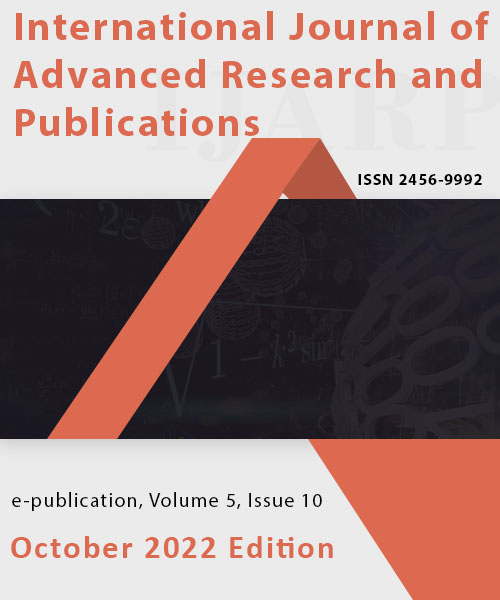Effects Of Wood Defects On Domestic Sawn Timbers And Its Implications On Market Value In Kenema City Eastern Sierra Leone
 Volume 5 - Issue 10, October 2022 Edition
Volume 5 - Issue 10, October 2022 Edition
[Download Full Paper]
Author(s)
Ibrahim Robinson Kargbo, Sumaila Moiwo Sieyeh, Sanpha Kallon, Abdulia Barrie
Keywords
Conversion, Defects, Market values, Seasoning,
Abstract
This study was conducted to identify the various defects on sawn timber in the research area, the causative agents responsible, and its implication on market value .Data was collected from 40 respondents through well-structured and pre-tested questionnaire. Data was analyzed using Statistical Package for Social Scientists and the result gathered are presented in pie chat, bar chat and tables. Result of the research shows that 35.0 % of timber defects emerges during transportation, 35% during storage, followed by processing (17.5%) and the least (12.5%) through seasoning. Highest percentage (65.0%) of timber defects occur during the dry season next to the raining season with 17.5% and those that occurs in both seasons (17.5%) falls on the same scale. It was also revealed that other forms of abnormalities such as Checks, Splits and Shakes, accounted for 40%, next was Wrapping with 20.0 %, followed by Stain and Decay 15.0 %, Knot 10.0 % , Collapse 7.5 % , Wane 5% , and Miscut 2.5% respectively. In this regard 45.0% of the timber buyers paid base on reduction in price irrespective the level of damage on the timber, while 22.5% pay if the defect is mild and low. However 32.5% were not willing to pay even if the price is reduced. In lieu of the above 57.5 % of the respondents said they experienced severe income reduction, followed by 32.5 % who indicated mild income reduction, while 10.0 % of the respondents envisaged slow income reduction. The various defects caused reduction in value chain as well as environmental threats within the study area. Conclusively the research revealed that majority of the respondents believed that the causes of timber defects is as a result of the poor transportation, improper seasoning and lack of storage facilities consequently led to poor market condition.
References
[1]. (Janvi Desai (2020). Different types of defects in timbers as a building material. Kamal bhusal (2010); Defects in Wood-Forestry.
[2].Ron Smith (2016). Understanding and working with wood defects/Woodworking Network. American www.alumber.com
[3].Maree, B. and Malan, F. S., (2000). Growing for solid wood products – a South Africa experience and perspective. In: The future of Eucalyptus for wood products, proceedings of IUFRO Conference, launces ton, Tasmania Australia, 19-24 March 2000, pp. 319- 327.
[4].Naeem Javid Muhammad Hassani,( 2019). Weed Defect Forestrypedia.Published with Hindawi, https://forestrypedia.com
[5].Karen Bayne, (2015).Wood quality considerations for radiata pine ininternational markets. Journal of Forestry, February 2015, Vol. 59, No. 4
[6].Moses Fayia, (2021). Uncertainities and trends in the forest policy framework in Sierra Leone: an overview of forest sustainability challenges in the post-independent era. International Forestry Review Vol 23(1), 2021 1, 2021.
[7].John W. Creswell- Research Design: Qualitative, Quantitative and Mixed Methods Approaches. 4thEdition ISBN-13:978-145222610105
[8] Population and Housing Census (2015) Summary of Final Results Planning a Better Future. Supported by UNDP.
[9] Seema Singh,( 2018’)Sampling Techniques. https://towardsdatascience.com/sampling-techniques-a4e34111d808
[10] University of Maryland Extension,2018-2021. Wood Rots and Decay on Trees and Shrubs interactions between wood-inhabiting fungi and termites: a meta-analytical review
[11].Arleu Viana-Junior,Arleu Viana-JuniorMariana ,. CôrtesMariana , CôrtesTatiana CornelissenTatiana , (2018).CornelissenFrederico Interactions between wood-inhabiting fungi and termites: a meta-analytical review DOI: 10.1007/s11829-017-9570-0